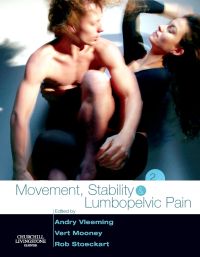The human lumbopelvic area has become the focus of a considerable amount of new and intriguing research relevant to effective diagnosis and treatment of low back pain. Back function has recently been studied from a broader perspective, including the analysis of the coupled function in spine, pelvis and legs. These approaches lead to new questions about dynamic stability and motor control in general, and specifically about the spine and pelvis. These new insights obviously imply new approaches in the prevention and treatment of low back pain and pelvic pain.
Unique to this book is its in-depth coverage of this subject area by a team of international contributors who represent the broad range of professionals involved in clinical research and therapy. These experts cover a vast area of lumbopelvic experience, from effective treatment and rehabilitation to epidemiology, anatomy, biomechanics, pain and motor control, surgery and manual therapy.
New to this edition
- New high-profile contributors
- Updated references and guidelines
Key Features
- Evidence -based focus
- Final conclusions including perspectives with each chapter
- Each chapter is relevant and up to date
Author Information
By Andry Vleeming, PhD, PT, Clinical Anatomist and Founder, Spine and Joint Center, Rotterdam, The Netherlands.; Vert Mooney, MD, Clinical Professor of Orthopaedics, USSD, Private Practioner, San Diego, CA, USA and Rob Stoeckart, PhD, Department of Neuroscience, Erasmus MC, Rotterdam, The Netherlands
PART 1 Biomechanical, clinical-anatomical and evolutionary aspects of lumbopelvic pain and dysfunctionSECTION 1 Clinical-anatomical aspects1. The muscular, ligamentous and neural structure of the lumbosacrum and its relationship to low back pain, FH Willard2. Anatomical linkages and muscle slings of the lumbopelvic region, C DeRosa, J Porterfield3. Anatomy and biomechanics of the lumbar fasciae: implications for lumbopelvic control and clinical practice, PJ Barker, CA Briggs4. Clinical anatomy of the anterolateral abdominal muscles, DM Urquhart, PW Hodges5. Clinical anatomy of the lumbar multifidus, L Danneels6. Clinical anatomy and function of psoas major and deep sacral gluteus maximus, S Gibbons7. The SIJ, sensory-motor control and pain, A Indahl, S Holm8. The role of the pelvic girdle in coupling the spine and the legs: a clinical-anatomical perspective on pelvic stability, A Vleeming, R StoeckartSECTION 2 Evolution, biomechanics and kinematics9. Evolution of the human lumbopelvic region and its relationship to some clinical deficits of the spine and pelvis, CO Lovejoy10. Kinematic models and the human pelvis, A Huson11. How to use the spine, pelvis and legs effectively in lifting, MA Adams, P Dolan12. Is the sacroiliac joint an evolved costovertebral joint? S Gracovetsky13. The evolution of myths and facts regarding function and dysfunction of the pelvic girdle, D LeePART 2 Insights in function and dysfunction of the lumbopelvic region14. Anatomical, biomechanical and clinical perspectives on sacroiliac joints: an integrative synthesis of biodynamic mechanisms related to ankylosing spondylitis, AT Masi, M Benjamin, A Vleeming15. A suspensory system for the sacrum in pelvic mechanics: biotensegrity, SM Levin16. Why and how to optimize posture, RE Irvin17. Gait style as an etiology to lower back pain, HJ Dananberg18. A detailed and critical biomechanical analysis of the sacroiliac joints and relevant kinesiology: the implications for lumbopelvic function and dysfunction, RL DonTigny19. Stability or controlled instability? S GracovetskyPART 3 Diagnostic methodsSECTION 1 Visualization in relation to pelvic dysfunction20. Basic problems in the visualization of the sacroiliac joint, PF Dijkstra21. CT and MRI of the sacroiliac joints, JMD O’Neill, E Jurriaans22. Visualization of pelvic biomechanical dysfunction, T RavinSECTION 2 The pelvic girdle23. Movement of the sacroiliac joint with special reference to the effect of load, B Sturesson24. What is pelvic girdle pain? HC Ostgaard25. The pattern of intra-pelvic motion and lumbo-pelvic muscle recruitment alters in the presence of pelvic girdle pain, B Hungerford, WGilleard, P Hodges, D LeeSECTION 3 Low back26. Different diagnosis of low back pain, SV Paris27. Conditions of weight bearing: asymmetrical overload syndrome (AOS), JA Porterfield, C DeRosa28. Evidence-based clinical testing of the lumbar spine and pelvis, M LaslettPART 4 Guidelines29. European guidelines for prevention in low back pain, G Muller on behalf of the COST B13 Working Group on European Guidelines for Prevention in Low Back Pain30. Evidence-based medicine for acute and chronic low back pain: guidelines, M van Tulder, B Koes31. European guidelines on the diagnosis and treatment of pelvic girdle pain, A Vleeming on behalf of the COST B13 Working Group on European Guidelines for Diagnosis and Treatment of Pelvic Girdle PainPART 5 Effective training and treatmentSECTION 1 Psychological, social and motivational aspects32. Behavioral analysis, fear of movement/(re) injury and cognitive-behavioral management of chronic low back pain, JWS Vlaeyen, LMG van CleefSECTION 2 Motor control33. Functional control of the spine, PW Hodges, J Cholewicki34. Motor control in chronic pain: new ideas for effective intervention, G Lorimer MoseleySECTION 3 Different views on effective training and treatment35. The painful and unstable lumbar spine: a foundation and approach for restabilization, SM McGill36. Important aspects for efficacy of treatment with specific stabilizing exercises for postpartum pelvic girdle pain, B Stuge, NK Vollestad37. Breathing pattern disorders and back pain, L Chaitow38. Effective rehabilitation of lumbar and pelvic girdle pain, V MooneyPART 6 Integrating different views and opinions when dealing with a complex system39. An intregrated approach for the management of low back and pelvic girdle pain – a case report, D Lee40. An integrated therapeutic approach to the treatment of pelvic girdle pain, D Lee, A Vleeming
"The work is full of amazing facts to ponder."Robert McWilliams, Structural Integration, June 2008




